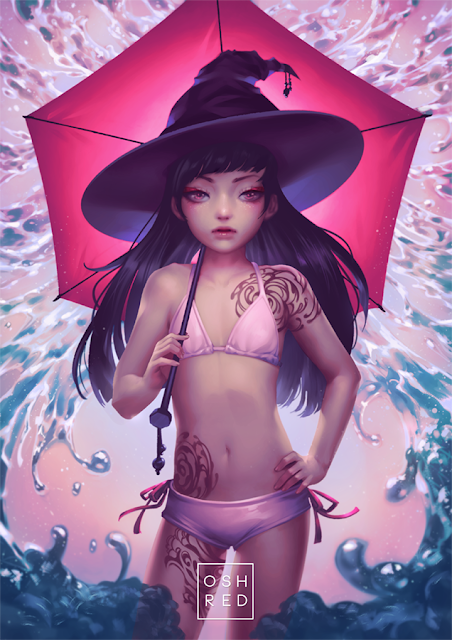Nathan Fawkes Color study
Nathan Fawkes explains his color process as a process of pushing and pulling colors back and forth in the piece by manipulating the three characteristics of color: hue, saturation and value. He starts his demonstration with putting a few colors next to one another that are all heavily saturated and clash together and then goes about demonstrating how changing the value of the colors, desaturating them and ultimately tieing them together with a blue that sits over all the colors will make them look harmonized.
This is something to keep in mind when you run into a painting situation and you fell like your colors are too boring, that would be a good time to add contrast. IF your painting is too garish then that means it has too much unity on one of the key levels and you can find this by making the painting grey scale and seeing how you can unify the colors by dropping the values of one color or more to put them together. If the piece is too saturated try finding places to neutralize.
Its a interesting thing I've noticed as I've done these analysis articles: sometimes you will find an exceptionally beautiful painting and when you turn in black and white you assume every brushstroke of color is going to be represented as tons of different individual values but actually they often disappear to reveal one shape of value.
Now as we look at this painting we can see these principles and others at play here. From watching his videos I would assume he starts the piece with a light sketch and drops in the blue background and the light yellow sun beam that cuts across the page before blocking in the more desaturated and darker values on the left and the right.
When I look at the left of the image the first thing I see is the contrast he creates by bringing in dark reds and oranges to create the underbelly of the branch and then uses these darker colors as a place to lay the more saturated and lighter value colors of the blue and greens.I say lighter value just because it goes up on the scale as the color becomes more saturated it also increases its value, but I have noticed that in this piece anyway he doesnt put as many greys down as i thought, this is a tendency I have of always sticking to the left side of the grey colors and this is something I need to unlearn.
So immediately on one side of the piece we have a high contrast of warm shadows and cool light that hits the birds, and we get a similar contrast with the heavily grey shapes on the far right which is our next focal point. As i color pick my way around his painting I'm reminded of how marco bucci would put down many colors in a painting and so long as he keeps them in the right value or saturation range they still end up working. I feel like we can really see that here in the trees. He has a wide assortment of colors found all throughout the tree shapes. Another thing I noticed was that he talks about using different colors as bridges from one to the other.
I thought this was interesting, so far example if he has a blue and red next to one another to connect them he will build a bridge with purple since purple has elements of both blue and red in it. We can see variations of this throughout the piece in the touches of purple and green on the birds, but also how the tree shapes change color as they go further back into the landscape and get lost in the atmosphere of the background. Below is a breakdown and matching of




Comments
Post a Comment